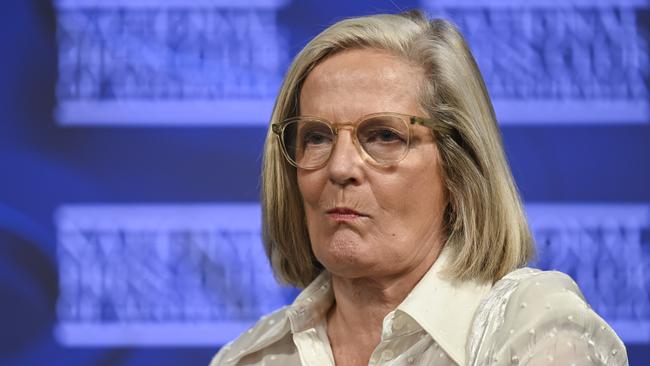Adelaide planning tsar urged to overcome resistance from NIMBYs
A planning tsar is being urged to spearhead Adelaide’s future development and help ease housing shortages.

SA News
Don't miss out on the headlines from SA News. Followed categories will be added to My News.
An independent planning tsar to spearhead Adelaide’s future development is being pushed to overcome resistance from NIMBYs and local councils to vital housing and infrastructure projects.
Housing industry groups are calling for an independent body with a strong leader modelled on the Greater Sydney Commission (GSC), which under inaugural chief Lucy Turnbull charted a 40-year vision for that city’s growth and development.
Raised by the chief executive of major retirement living accommodation and aged care services provider ECH, Claire Scapinello, the proposal also has been backed by Adelaide Crows chairman John Olsen, who as Liberal premier in the late 1990s installed a major projects tsar to bust through bureaucracy.

Ms Turnbull told The Advertiser that collaboration was the key to the GSC’s achievements, because “so often in public administration the left hand has no idea what the right hand is doing”.
Responding to the proposal, Premier Peter Malinauskas said a co-ordinator-general’s position was being considered with “wide-ranging powers to plan, deliver and co-ordinate large-scale infrastructure projects, while ensuring their environmental impacts are properly managed”.
Ms Scapinello said future planning of Adelaide needed a dedicated leader who could engage with the community in the interests of the entire metropolitan area.
This would examine potential affordable housing sites and plan for health, transport and other infrastructure, referencing local councils’ views.
“What does the infrastructure look like for the next 20 years to 30 years in South Australia? Where will we be connecting the city, so how will the city get connected together?“ she said.

Ms Scapinello said the Greater Sydney plan was impactful because it had a strong figurehead in Ms Turnbull, a former Lord Mayor, and future Adelaide planning needed “a dedicated role that really can engage with the community”.
“We have three tiers of government, and councils have an interest to look after the constituents of their area, but that is sometimes at odds with the actual need in the community to provide more housing,” she said.
Ms Turnbull said a critical idea of the Greater Sydney Commission was to work in partnership with local government, communities and stakeholders to deliver the metropolitan and five district plans, as well as 33 strategic plans for council areas.
“A central idea was to create a strongly connected city, where people could be closely connected from home to work, parks, green spaces, and the services, including health, education, retail, sport and recreation, that everyone needs and wants,” she said.
“ … There is a natural centrifugal force in government and larger enterprises towards fragmentation, the creation of many silos with high walls. Fragmentation and poor infrastructure delivery greatly suppresses liveability and connectivity, and ultimately, productivity. A well-connected city is liveable, prosperous, productive and more sustainable.” she said.
Mr Malinauskas said co-ordinated planning was crucial to well-organised development, highlighting the development of the Greater Adelaide Regional Plan – a 30-year blueprint to guide housing, employment, services, infrastructure and conservation areas.
“The Business Council of Australia has declared SA has the best planning system in the nation. We are the only jurisdiction to have just one statewide, user-friendly online planning system,” he said.
Mr Olsen, also the federal Liberal president, issued a veiled reference to community opposition to the Crows $100m Thebarton Oval redevelopment when calling for an objective group to look at long-term city planning.
“There needs to be a comprehensive overview and planning body. There is no doubt about that in my mind. If I give you just one example – the Adelaide Football Club has embarked on the third public consultation on our Thebarton proposal in the last 12 months,” he said

Mr Olsen said an independent body would give greater clarity for investors and developers, as well as developing strategy for development for 30 or 40 years ahead.
“People see Adelaide as the greater Adelaide area. People don’t necessarily break it down into particular council areas. There are policies that across the greater Adelaide area cut across local government boundaries, and for that reason, an overarching policy would be an invaluable tool,” he said.
“It gives an overarching plan, which then takes into account the interests of the broader group while not being constrained by localised issues.”
Property Council of Australia SA executive director Bruce Djite acknowledged the state government was preparing a Greater Adelaide Regional Plan but said politics must be taken out of development to accelerate housing supply.
“A new central independent body responsible for co-ordinating the planning, assessment and approval of projects is urgently needed if we are to have a smarter, efficient, flexible, and fit-for-purpose process to match the increased demand and urgency for housing,” he said.
“We need to plan, assess and approve more projects. The clock is ticking on the NIMBY movement, their time is up.”

Master Builders Association of SA chief executive officer Will Frogley said much-hyped planning reforms had not delivered the faster, simplified approvals that the industry was promised.
“This is a major source of frustration for builders and homebuyers alike and is holding South Australia back. This suggestion is likely to have merit. The key will be getting the right people to drive progress,” he said.
Housing Industry Association SA regional director Stephen Knight said state and local governments needed to step up to deal with widespread public concern about lack of trees, green spaces and carparking, particularly for infill development.
“The builder in me says that a planning tsar is a great idea but if it leads to more regulations then we could end up in a worse place than we are now. … Every indicator we have shows that housing affordability and availability are our most critical challenges as a state and this won’t be fixed by making homes take longer to construct and be more costly to build,” he said.
More Coverage
Originally published as Adelaide planning tsar urged to overcome resistance from NIMBYs





